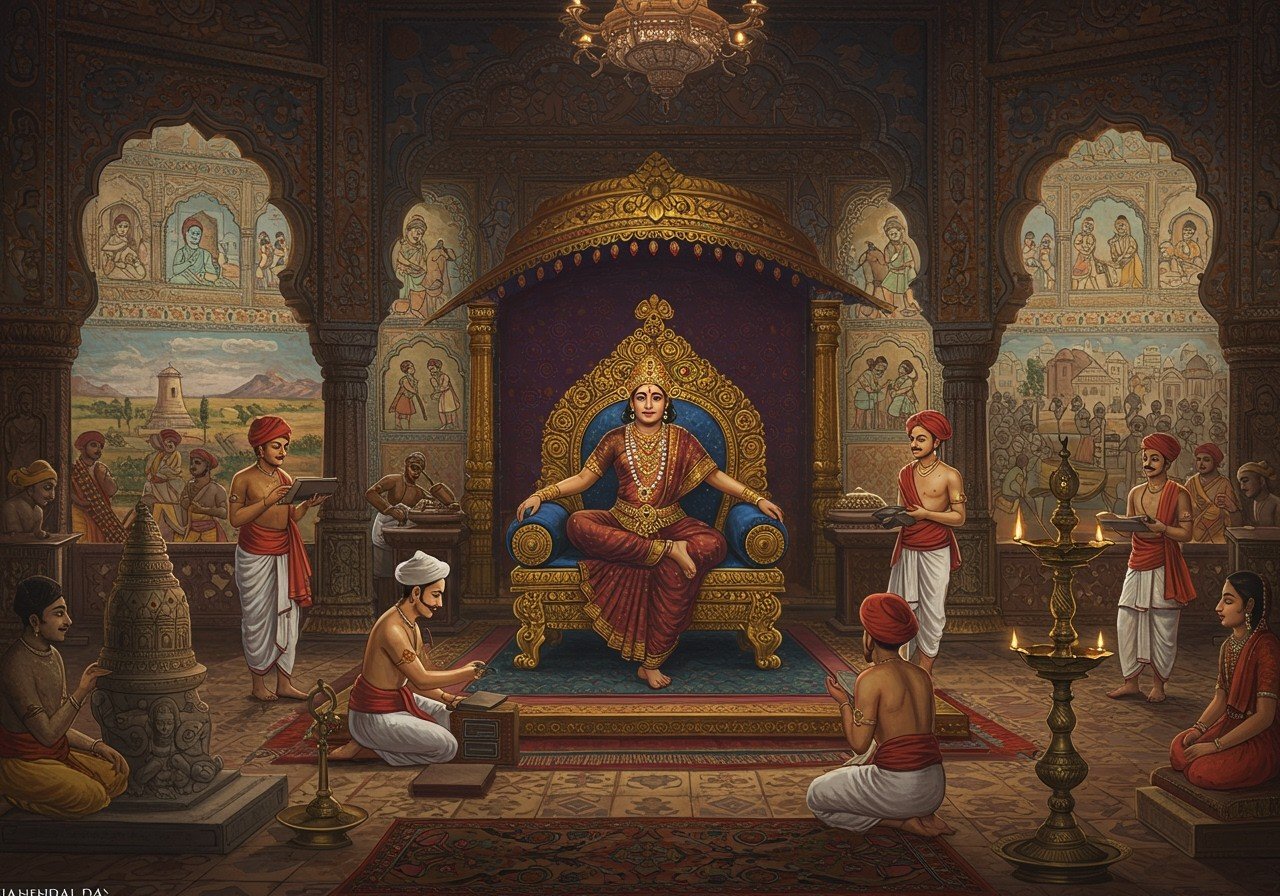
The Haryanka Dynasty stands as a cornerstone of ancient Indian history, emerging in the 6th century BCE. This dynasty significantly shaped the region’s traditions and culture. Examining the Haryanka Dynasty’s governance, cultural facets, and enduring legacy provides insights into India’s rich heritage and its influence on contemporary society.
Origins and Rise of the Haryanka Dynasty
Bimbisara’s Founding (circa 544 BC):
- Bimbisara established the Haryanka Dynasty, ruling Magadha, a prominent kingdom in ancient India.
- He strategically expanded his kingdom’s influence through alliances and matrimonial ties, solidifying his power and reach.
The Political Climate:
- During Bimbisara’s reign, ancient India comprised numerous smaller kingdoms, creating a complex political landscape.
- Bimbisara’s strong leadership consolidated power within Magadha, setting the stage for its rise to prominence.
Royal Succession:
- Following Bimbisara, his son Ajatashatru ascended to the throne, continuing his father’s expansionist policies and further strengthening Magadha.
- Udayin succeeded Ajatashatru, effectively maintaining Magadha’s dominance during his reign and shifting the capital to Pataliputra.
Magadha’s Pivotal Role:
- Magadha served as the Haryanka Dynasty’s power center, strategically located and benefiting from the fertile Gangetic plains.
- The Ganges River played a crucial role in trade and development, contributing significantly to the kingdom’s prosperity.
Challenges and Conflicts:
- Haryanka rulers faced constant challenges in maintaining control and stability amidst a dynamic political environment.
- Conflicts with neighboring kingdoms were frequent, requiring strategic alliances and military prowess to secure Magadha’s position.
Governance Under the Haryanka Dynasty
Centralized Authority:
- The king held supreme authority, with the royal court playing a vital role in governance and decision-making.
- This centralized system ensured efficient administration and control over the kingdom’s resources and affairs.
Bureaucratic Structure:
- A network of officials assisted in managing the kingdom’s various functions, contributing to an organized bureaucratic system.
- This structured bureaucracy ensured efficient administration and the implementation of royal decrees throughout the kingdom.
Legal Framework:
- Laws were established and enforced to uphold order and justice within the kingdom.
- A well-defined legal system contributed to social stability and reinforced the authority of the Haryanka rulers.
Military Organization:
- The Haryanka kings maintained a strong military, employing effective strategies to defend and expand their territories.
- A well-organized army was essential for maintaining control, suppressing rebellions, and projecting power in the region.
Economic Policies:
- Trade and commerce flourished under the Haryanka Dynasty, contributing significantly to the kingdom’s economic prosperity.
- A structured taxation system provided the necessary revenue to support the administration, military, and public works.
The Capital: Rajgir
Rajgir’s Significance:
- Rajgir (originally Girivraja) served as the initial capital of the Haryanka Dynasty, strategically chosen for its natural defenses and fortifications.
- Its location offered protection against invasions and allowed the rulers to consolidate their power base securely.
Architectural Advancements:
- Rajgir witnessed substantial urban development and architectural growth, reflecting the dynasty’s prosperity and cultural advancement.
- The city became a hub for cultural and religious activities, attracting scholars, monks, and artisans.
Cultural Importance:
- Rajgir held significant religious importance, associated with both Buddhism and Jainism, making it a pilgrimage destination.
- Festivals and celebrations played a vital role in the city’s cultural life, fostering a sense of community and religious devotion.
Trade and Commerce:
- Rajgir served as a major center for trade and commerce, facilitating interactions with neighboring regions and contributing to economic growth.
- Its strategic location on trade routes enabled the exchange of goods and ideas, further enriching the kingdom’s cultural landscape.
Poojn.in: Connecting You with India’s Rich Heritage
At Poojn.in, we offer a wide selection of authentic puja items, enabling you to connect with India’s rich spiritual traditions. Explore our collection of handcrafted items:
- Brass Laddu Gopal Murti: Perfect for your home altar, reminiscent of deities worshipped during ancient times.
- Clay Pots (Hadi Kundo): Similar to those used in ancient rituals and ceremonies.
- Arjun Chal: A traditional ingredient used in Ayurvedic practices for centuries.
Visit www.poojn.in to discover our complete range of puja essentials and experience the heritage of ancient India.
Conclusion
The Haryanka Dynasty holds a significant place in ancient Indian history. Their administrative structure and cultural practices laid the groundwork for many traditions still honored today. From the influential reigns of Bimbisara and Ajatashatru to the cultural hub of Rajgir, the Haryanka Dynasty’s contributions are undeniable. Understanding this era allows us to appreciate India’s rich heritage and its lasting impact on modern society. Studying dynasties like the Haryankas not only pays homage to our ancestors but also connects us to our cultural roots.
Frequently Asked Questions
What was the Haryanka Dynasty’s capital? Rajgir, initially known as Girivraja, served as the capital.
What language was prevalent during the Haryanka Dynasty? Magadhi Prakrit was the primary language spoken.
What type of currency did the Haryanka Dynasty use? Punch-marked coins made of silver and copper were the common currency.
How was the Haryanka Dynasty’s administration structured? The administration was centralized, with the king as the supreme authority, supported by ministers and local governors.
What were the key cultural aspects of the Haryanka Dynasty? The dynasty contributed significantly to early Buddhism and promoted Vedic traditions.
Who were the prominent rulers of the Haryanka Dynasty? Bimbisara and Ajatashatru were notable rulers who played crucial roles in expanding the kingdom and supporting Buddhism.
What architectural styles did the Haryanka Dynasty foster? The dynasty promoted the construction of stupas, viharas, and forts, particularly in Rajgir.
How did the Haryanka Dynasty influence subsequent dynasties? The administrative and cultural practices of the Haryanka Dynasty established fundamental principles that shaped later dynasties in ancient India.
Explore related articles on ancient Indian history:


